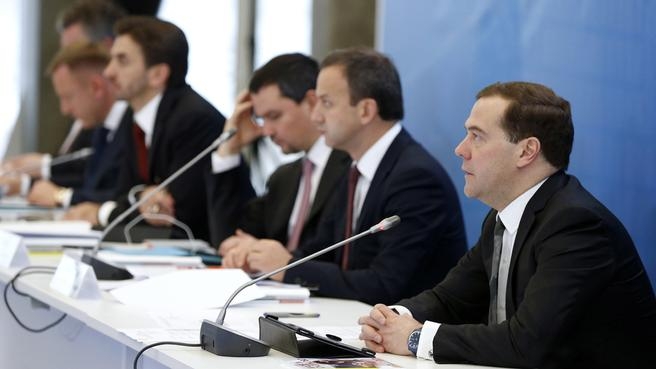Meeting of the presidium of the Presidential Council for Economic Modernisation and Innovative Development.
From Dmitry Medvedev’s opening remarks:
Today we are going to discuss the progress made under our innovation-based development strategy. The document was approved by order of the Government on 8 December 2011. The goal it set was to put the economy on the path to innovation-based development by 2020.
Most of the basic support infrastructure was created in a very limited period of time. The Skolkovo innovation hub was a green field only a few years ago; today it is home to over a thousand startups. The Skoltech graduate research university, a world-class academic centre, will open soon too. There are other development institutions apart from Skolkovo, which also provide support to innovative projects – the Russian Venture Capital company, Rusnano, Vnesheconombank within its competency, the Foundation for Assistance to Small Innovative Enterprises, and other institutions.
Other forms of cooperation between people engaged in innovation are also on the rise, including technology platforms and territorial innovation clusters: all in all there are over 30 platforms and 25 clusters.
A network of federal universities – national research universities and leading research facilities – has been established. The government is investing in research infrastructure, as well as in foreign researchers who are interested in working in Russia.
Another important priority is to encourage cooperation between universities and high-tech industries. Government financial support for civilian R&D projects has reached 370 billion roubles a year.
It is also essential to support innovation at state companies. As many as sixty companies co-owned by the government are implementing innovative projects, with total funding exceeding 1.3 trillion roubles. Our goal is to maintain growing investment in research, which should in turn increase labour productivity.
We have ambitious targets for annual growth in labour productivity. It is extremely important to eliminate the critical dependence on foreign technologies in many industries – machine-tool and equipment manufacturing, power engineering, and oil and gas equipment engineering. We need to encourage reasonable import substitution, which should increase the number of competitive industrial enterprises.
Implementing our strategy, we
have started working on several cross-industry roadmaps. I am referring to
important and promising industries such as IT, photonics, biotechnology,
engineering, industrial design, high technology for the fuel and energy sector,
composite materials and so on. The Government is cooperating with other organisations,
public associations, the Agency for Strategic Initiatives, and the Academy of
Sciences. We will jointly develop proposals for the national technology
initiative that the President spoke of in his state-of-the-nation address.
Training a high-skilled workforce and engineers for innovative projects is an important task. Our approach to it should rely on the best foreign standards and practices such as national skills championships. In education, there is a programme of social support for citizens who enrolled in leading foreign universities on their own. We will continue to improve our regulatory system, including for intellectual property, because this is very sophisticated legislation which is only just starting to be developed in our country. We will continue this work as well as work to build support infrastructure for fairly large projects such as, for example, Innopolis in the Republic of Tatarstan.
Attention needs to be focused on problems that emerged during the first stage of this strategy. According to federal executive bodies and the Analytical Centre for the Government, we have 45 target indicators, one-third of which have not been met. Despite a number of fairly successful projects, there remain significant disparities in the innovative development of various regions and industries.
It’s time to fully deploy the
potential that has been created in effective and concrete projects and to
concentrate the resources of state programmes, educational centres, development
institutes and, of course, private business, which still has significant
potential that can be used.
<…>








